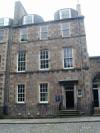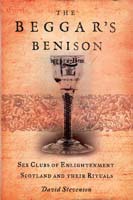|
George Square at the University
of Edinburgh
In August of last year, John Beatty (your editor,
pretending he isn't writing this article) had the good fortune to present a paper
for the School of Scottish Studies at the University of Edinburgh. While there,
He noticed that two of the houses had interesting plaques on them indicating
that two famous Scots had lived in the houses in George Square. Both Sir Arthur
Conan Doyle and Sir Walter Scott lived in the buildings on the square.
|
In this house Sir Walter Scott lived 1774-1797 click on thumbnails for a larger image in a popup window.


|
|
In this house lived Sir Arthur Conan Doyle,
from 1876-1880 as the sign below indicates.


|
|
BOOK REVIEW
Beggar's Benison
Sex Clubs of Enlightenment Scotland and their Rituals
Donald Stevenson
Tuckwell Press
18.99 pounds
|  |
The Beggars Benison by Donald Stevenson is a fascinating book about one of Scotlands
secret societies. Although Free and Accepted Masonry is often associated with
Scotland, this free trade/free sex organization with its obvious connections to
Londons Hellfire Club is somewhat less known. Begun in Fife in 1732 it had a
parallel in the Wig club founded in Edinburgh (1773).
The book documents the organization which appears to have been in existence from 1732 (officially
1739) until 1836.
The Stevenson traces the development of the organization and its relationship to smuggling, taxation
and fair trade (which he points out was popularly construed to mean free trade).
Fair trade technically meant paying customs and excise duty and so on, while
free trade meant exactly the opposite no regulations and duty. The problems
resulting from the parliamentary union of 1707 involved customs and excise in an
English, not Scottish manner (i.e. rather than low, indirect and ramshackle
collection, they were now higher - often by several hundred percent and
carefully collected). Worse they were seen as being used for the English fiscal
economy! The predictable result of course was that smuggling became a major pass
time and Scotlands biggest service economy.
With the Enlightenments rejection of Puritanism, it doesnt take a great leap of
imagination to see that sex became freed from its shackles and was part and
parcel of an expansionist policy in the government. Stevenson points out that
Taking possession and then usually discarding was central to satisfaction.
Colonization, conquest, invasion, possession of territory were often involved as
metaphors. The linking of the idea of free trade with one of free love and/or
free sex was an easy step.
The book is fascinating and well written It does a great deal to let the reader see the
relationships between the political, economical, moral and sexual concepts that
were popular at the time of the Benison.
A number of artifacts from the organization remain and photographs of several appear in the
book. This is definitely required reading for people who are interested in the
more arcane aspects of Scotland should have and is a real find for people
interested in the history of ideas and culture in Scotland. Although the focus
is on a rather unusual organization, the book illuminates a time period in
Scotland from many perspectives and deserves a wide readership.
PAGE TWO
TABLE OF CONTENTS
PAGE FOUR
|